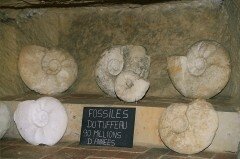Mushroom museum... in Saumur
Mushroom museum...
© Sedecs/Terroirs-of-France/ M. Durman |
...one of the most visited sites in Saumur
Quite a unique place, the Mushroom museum of Saumur, was created in 1978 and received millions of visitors. It is one of the most visited sites in Saumur.
Today, thousands of kilometers of these galleries have been put into different uses. A major part have been used for mushroom farming.
The conditions are ideal. The caves are dark, have a constant temperature of 15 degrees and the humidity level is over 90%. Mushrooms grow on a mixture of wheat straw and manure (horse droppings), well available in Saumur, the town being one of the capitals of horsemanship. Today 70% of French production comes from Saumur area, that is about 500 tons a day. France is the 4th major producer of mushrooms after the U.S, China and Holland. Mushroom production is quite delicate and requires the know-how of a mushroom grower.
The museum displays the various stages of the production of Saumur's famous champignons de Paris (button mushrooms) plus some more exotic varieties as well, like Oyster mushrooms, shii-take or wood blewits. |
|
© Sedecs/Terroirs-of-France/ M. Durman |
In Saumur, the culture of mushroom is done in metal containers, in two superimposed vats. The culture in wooden vats was abandoned, as the wood generated bacteria. The vats must be regularly emptied and the mushroom bed cleansed. The first three weeks the mushrooms push in groups, then they are detached from each other. The wider the mushroom head the tastier the mushroom.
The visit starts with a display of a number of fossils found in the rocks, a collection of old tools used to work the tufa stone and a sample of the way the stones were extracted. Various rooms follow where one can see the different ways mushrooms were in the past and are cultivated today. |
|
© Sedecs/Terroirs-of-France/ M. Durman |
In the room of exotic mushrooms, one can discover mushrooms not cultivated in France, but which may be found at the natural state in the forests. These mushrooms are especially cultivated in China and in Japan for their medicinal virtues such as the Collybie in Japan, Pholiote Nameko, Hairy Coprin from which ink is extracted. One is known as the immortal, and it is offered to the young brides in the Far East to wish them longevity; it pushes on stocks of oak, and has anti-ageing virtues.
The room of the boletus presents Pied Bleu mushroom which has a lot of flavour, but should be consumed cooked. It grows very slowly.
After the cultivated button mushroom Shii-Také is the mushroom most produced in the world. The Japanese use it for the body. 80% of this mushroom produced in France is intended for pharmacy. It is thought that it may reduce cholesterol levels in the blood.
The grey Pleurotes grow fastest. As the mushroom is attracted by light, it is cultivated it on a substance made up of an agglomerate wrapped in a black plastic sheet with holes in some places. The bouquets appear and growt outwards. |
|
© Sedecs/Terroirs-of-France/ M. Durman |
In the Wild Mushroom Museum section, there is a great display of many types of mushrooms beautifully set out in display cases.
After visiting the daily environment of the mushrooms through the different steps of cultivation by the different means of farming, one can sample some mushrooms offered by the café just outside and learn a couple of quick recipes.
We would like to thank Mrs Catherine Poudret for her hospitality and the information provided. We would also like to thank the CDT of Anjou.


/https%3A%2F%2Fprofilepics.canalblog.com%2Fprofilepics%2F2%2F6%2F267002.jpg)







/https%3A%2F%2Fstorage.canalblog.com%2F40%2F39%2F309584%2F127054063_o.jpg)
/https%3A%2F%2Fstorage.canalblog.com%2F94%2F69%2F309584%2F127026414_o.jpg)
/https%3A%2F%2Fstorage.canalblog.com%2F13%2F22%2F309584%2F127013488_o.jpg)
/https%3A%2F%2Fstorage.canalblog.com%2F39%2F95%2F309584%2F126987670_o.jpg)